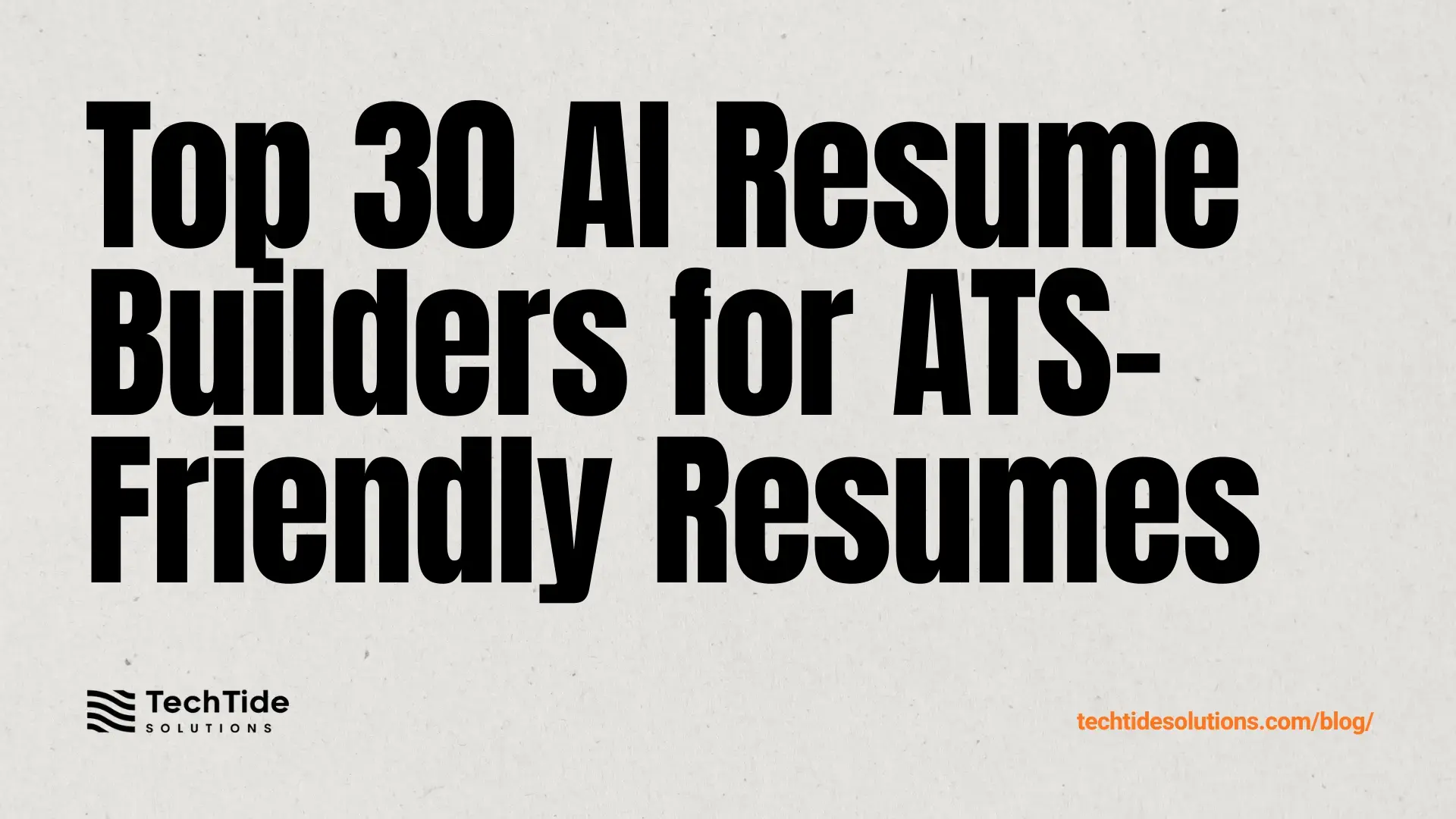We at Techtide Solutions have spent years building, scaling, and rescuing web applications across industries—from fintech platforms juggling complex compliance to media sites that spike under celebrity-driven traffic. The stakes are high: the application development software market reached $21.0 billion in 2023, a reminder that technology choices compound into real business outcomes. This guide distills how we evaluate languages and stacks in practice, where the trade‑offs hide, and how to match your needs to the tools that pay dividends rather than debts.
What Are Web App Languages and How They Differ From Other Programming Languages
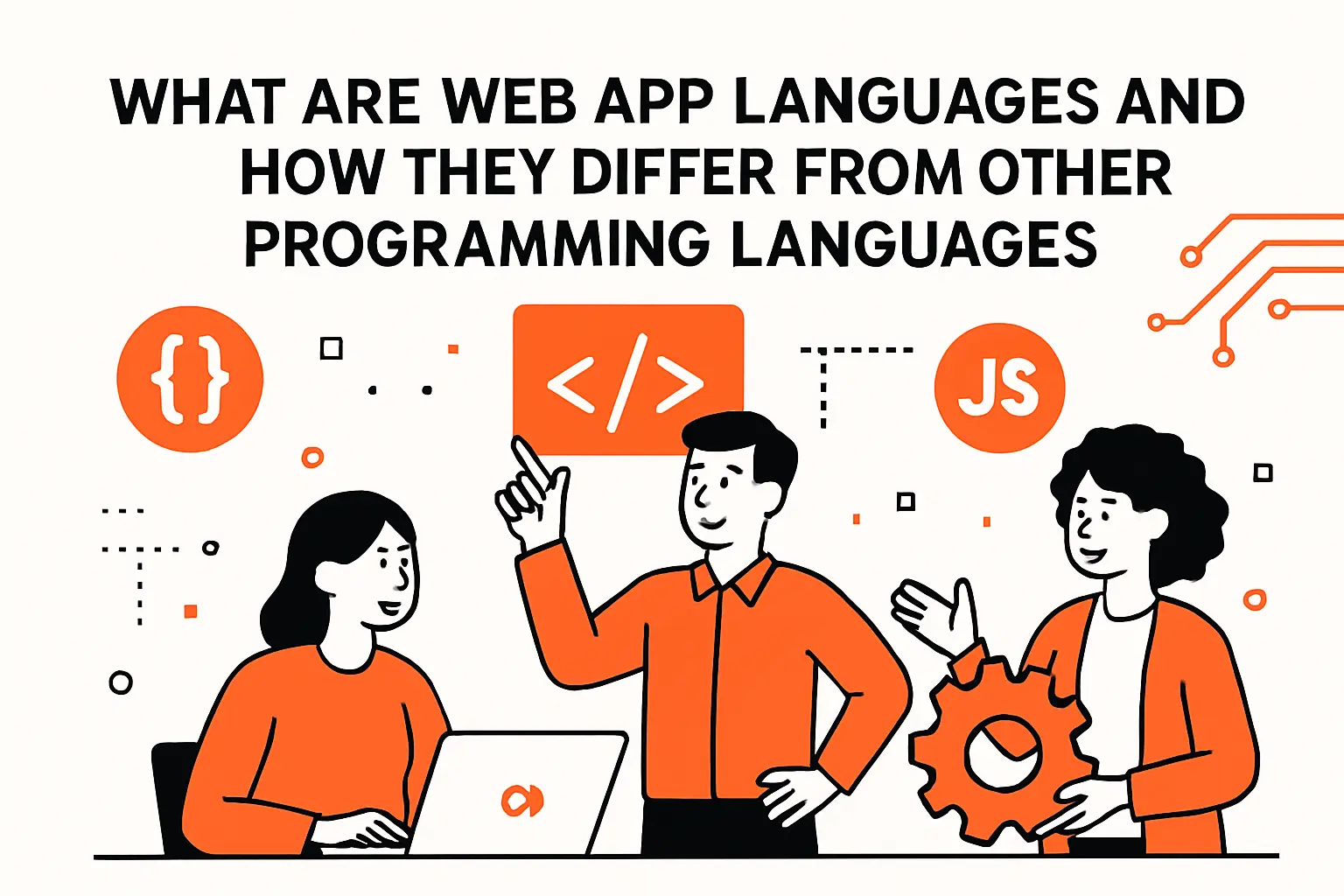
Before arguing over frameworks or performance, we start from a simple truth: language decisions are business decisions. In digital programs that succeed, strategy and action interlock; the right combinations unlock value the wrong ones bury. Deloitte’s analysis showed that well-orchestrated digital moves can generate US$1.25 trillion in market capitalization, underscoring why language and architecture choices must map to value creation, not fashion. With that lens, here’s how we frame the terrain.
1. Definition of Web Application Development
We define a web application as software delivered over the network that performs interactive, stateful functions on behalf of users or systems. Unlike static publishing, a web app mediates business processes: onboarding a lender, negotiating an order workflow, adjudicating a claim, validating a digital signature, or coordinating a field technician’s schedule. Data flows through the app, not merely past it, and the stack’s job is to shepherd state, security, and consistency while sustaining a responsive, humane user experience.
Viewed this way, “web app languages” are the languages in which we implement the contract between product intent and operational reality. They express business rules, encode integration behavior, and serve as the substrate for performance, cost, and maintainability. The browser is only one endpoint; the app is the living system that makes the browser meaningful.
In our practice, we treat “web app” as a boundary around outcomes: if there’s logic, identity, and stateful interaction, we’re in application territory—regardless of whether the experience spans a browser, a mobile shell, or embedded screens on a factory floor.
2. Web Applications Versus Websites
Websites aim to communicate; web applications exist to transact. A site might tell a story; an app must enforce rules. That distinction flips the priority stack. For websites, content management, editorial workflow, and search engine friendliness dominate. For applications, we design for concurrency, idempotency, data integrity, and zero‑trust integration. Authentication, authorization, audit trails, and policy as code become first‑class requirements.
Take an e‑commerce catalog as an example. Static pages and a headless CMS might suffice to present inventory. The moment you add complex pricing, promotions, credit checks, returns, and omnichannel fulfillment, you’re in application territory. Now the right language choice can lower cognitive load, harden invariants, and keep latency from becoming a silent tax on conversion.
We have seen teams rush ahead with a content‑centric stack and then backfill application semantics with brittle plug‑ins and unvetted extensions. It rarely ends well. If the job is to enforce rules, start with an application mindset and languages that help you encode them cleanly.
3. How Programming Languages Work
Under the hood, programming languages trade off between developer ergonomics, runtime characteristics, and ecosystem maturity. Some emphasize expressiveness and fast iteration; others favor predictability and performance. Interpreted or just‑in‑time compiled languages lean toward rapid feedback loops, while ahead‑of‑time compilation can tighten control over footprint and startup behavior. Memory management strategies (automatic versus manual) influence both latency profiles and the complexity budget your team must carry.
Related Posts
- What Is Web Design? Definition, Principles, Responsive vs. Adaptive, Tools and Careers
- What Is Web Development? Definition, Core Technologies, Roles, Life Cycle, and Methodologies
- The 12 Agile Principles: A Practical Outline for Modern Teams
- What Is Python Programming: Definition, Features, Uses, and How to Get Started
- Nike Digital Transformation: Strategy, Real-World Examples, And Lessons
Equally important are the affordances that shape how your system evolves: module systems, type systems, concurrency primitives, metaprogramming, and testing libraries. A language’s standard library and build tooling can either keep you in the “pit of success” or leave you assembling basics while deadlines loom. We care less about macrobenchmarks and more about the confidence a language gives teams to change code safely.
Finally, languages live inside an ecosystem. Package managers, framework quality, documentation, and security posture (from dependency signing to vulnerability remediation cadence) often matter more than instruction-throughput claims. We’ve rescued more systems from ecosystem drift than from raw performance limits.
4. Are Web App Languages Different From Other Programming Languages
Not inherently. General‑purpose languages become “web” when coupled with the right runtimes, frameworks, and I/O models. JavaScript feels “webby” because it ships in browsers and runs on event loops. Python powers APIs because its frameworks and data tooling shorten feedback cycles. Go and Java earn back‑end credibility by offering strong concurrency models and predictable performance characteristics. C# thrives with a robust web runtime and tooling story.
So the question is not whether a language is “for the web,” but whether its runtime, libraries, and operational model fit your system’s interaction pattern. Is your workload I/O bound or CPU bound? Do you need strong static types to govern a sprawling codebase, or do you optimize for quick iteration on a rapidly evolving product hypothesis? The context decides.
When we coach teams, we urge them to ask: What invariants must never break? What latency spikes are tolerable? Where will we need observability? A “web app language” is any language that helps you enforce those answers under pressure.
5. Why Teams Adopt a Multi‑Language Strategy
Polyglot is not a fashion statement; it’s a risk‑management technique. Domains differ. A reporting pipeline may benefit from Python’s data stack, while a high‑throughput gateway calls for Go’s concurrency. A rule engine might fit best in Java or C#, where type systems and mature libraries help encode business invariants. Meanwhile, universal UI logic lives in JavaScript or TypeScript because the browser demands it.
We adopt multiple languages when the separation yields more clarity and safer change. Clear boundaries—via APIs and event streams—let each component evolve at its own cadence. The trap is accidental polyglot, where each team picks a new toy. We counter that with governance: an approved language list, a playbook for cross‑service contracts, and repeatable platform scaffolding so new services get observability, security, and testing from day one.
The payoff is not “using everything,” but “using the fewest languages that fully fit the work.” Constraint is part of the strategy.
Front‑End Foundations for Web Apps: HTML, CSS, JavaScript, and TypeScript
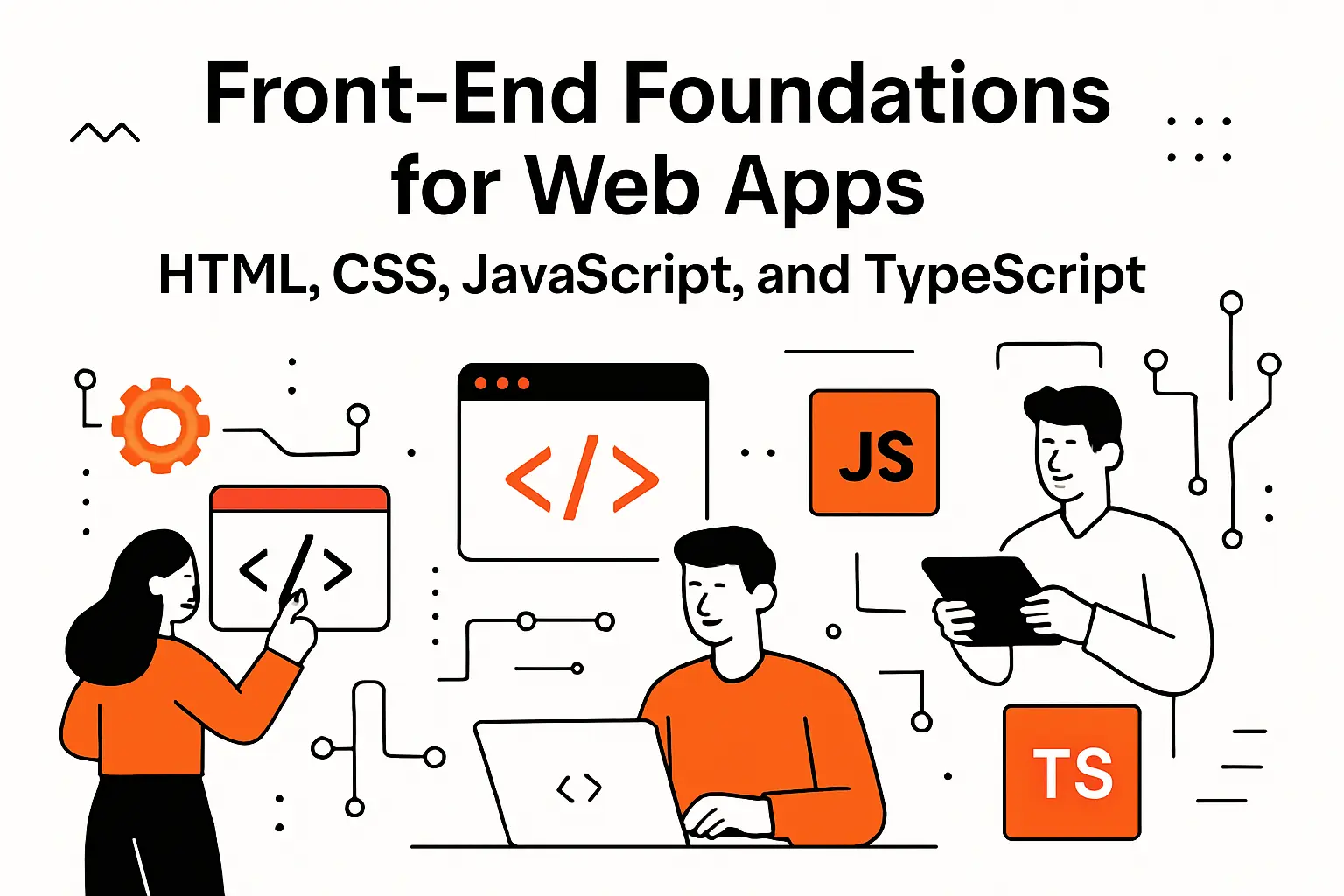
Front‑end choices shape customer perception and developer speed in equal measure. JavaScript’s ubiquity gives it gravitational pull—globally, it was used by 62 percent of surveyed developers—which is why we treat the browser as an application platform, not just a rendering target. But language is only one piece: semantics, accessibility, state management, and API design decide whether screens sing or stall.
1. HTML and CSS for Structure and Styling
Great web apps begin with honest HTML. Semantic tags aren’t just niceties; they are how assistive technologies, search engines, and automated testing reason about your UI. When we refactor tired pages, we often win back performance and accessibility simply by structuring the document properly, reducing unnecessary wrappers, and pairing form controls with explicit labels and error messaging.
Modern CSS is a design language in its own right. A layout expressed with flexible grid systems adapts to content changes and device classes without JavaScript acrobatics. Custom properties provide theming without heavy preprocessor layers, while container queries let components respond to their real space instead of global breakpoints. Thoughtful layering—base, layout, components, utilities—keeps stylesheets from calcifying into an untestable tangle.
We push teams to adopt accessible defaults: adequate color contrast, visible focus states, and predictable keyboard flows. It’s faster to do this from the start than to retrofit it later under compliance pressure. Our heuristic is simple: if the DOM is meaningful and the CSS is composable, everything above it becomes easier.
2. JavaScript for Interactivity and the DOM
JavaScript brings state and behavior to the party. The browser’s event loop handles bursts of interaction; promises and async functions help orchestrate I/O without freezing the UI. We try to keep the main thread light: batch DOM changes, schedule work with idle callbacks, and use workers for CPU‑heavy tasks. It’s remarkable how much interactivity you can deliver with small, targeted scripts when the HTML and CSS carry their weight.
Module boundaries matter. A clear separation between presentational components, state containers, and API clients reduces accidental coupling. Side effects should be explicit, not smuggled in through render cycles. We prefer predictable state transitions over clever patterns that dazzle during demos and disappoint during maintenance.
On the client–server seam, we treat errors as first‑class UX. Network hiccups happen; optimistic updates and graceful rollbacks can preserve flow without lying to users. The test suite should simulate failure as often as success.
3. TypeScript for Scalable, Maintainable Front Ends
TypeScript pays its rent in larger codebases and longer‑lived products. Static types create a safety net that makes refactoring boring—in the best sense. When models evolve or APIs change, the compiler becomes a collaborator. We favor narrow, well‑named types over sprawling “god” interfaces, and we keep generics purposeful rather than ornamental.
Types also serve as living documentation. A good type tells teammates how to use a component without pulling up a separate doc site. When we onboard new developers, the fastest ramp happens in codebases where types, tests, and stories agree with each other.
That said, TypeScript is not a license to over‑abstract. The best patterns earn their complexity by eliminating classes of bugs or by making intentions plain. Otherwise, we default to simpler constructs and treat runtime validation as a partner to compile‑time guarantees.
4. Popular UI Frameworks: React, Angular, Vue
React thrives on composability and a vast ecosystem. It excels when you need fine‑grained control over rendering and state, or when you plan to share components across multiple products. The cost is that architectural discipline is on you; React grants freedom, not guardrails.
Angular offers a batteries‑included approach. Its opinionated structure, dependency injection, and powerful templates suit teams that prefer convention over experimentation. If your application is large and your team appreciates strict patterns, Angular’s rigidity can be a virtue rather than a vice.
Vue often strikes a middle path with an approachable syntax and strong single‑file component ergonomics. The composition API lends itself to well‑factored logic sharing without the overhead of heavy state management frameworks. For teams building greenfield applications where devs value a gentle learning curve, Vue is a pleasant choice.
Trade‑Offs To Watch
Server‑side rendering, streaming, and hydration strategies differ across ecosystems. Pick the one that fits your cache strategy and infrastructure, not just your developer taste. Also consider how the framework influences bundle boundaries and code splitting; shipping less is a feature.
5. Front End–Back End Communication via APIs
The client–server handshake determines perceived speed and reliability. REST’s resource orientation remains a solid default when you can leverage HTTP semantics and caching. GraphQL shines when the client’s data needs vary by view and you want to avoid over‑ or under‑fetching. We insist on strong API contracts either way: schema validation, consistent error payloads, and versioning rules that don’t surprise integrators.
On the wire, we favor idempotent operations, pagination that behaves, and security that travels with the request: durable tokens, least privilege, and short‑lived grants. Observability must include the front end; synthetic monitoring and distributed traces that connect browser spans to server handlers turn “The page feels slow” into a fixable hypothesis.
Back‑End Web App Languages and When to Use Them
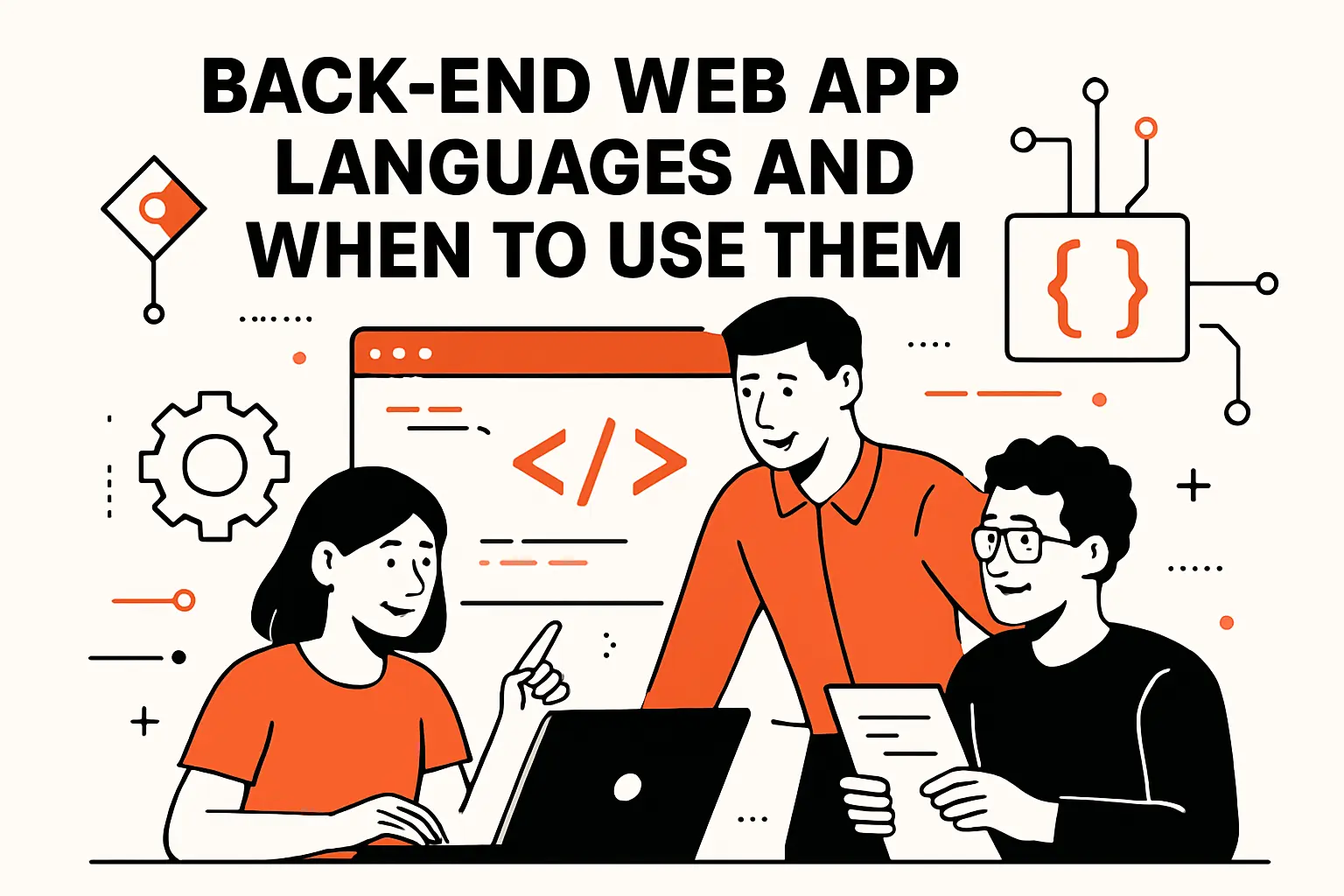
Behind every crisp screen is a back end that must be dependable on a bad day. The appetite for enterprise application software remains strong, with forecasts projecting a market of $580 billion in 2027. That demand rewards language choices that keep systems operable under load, maintainable under change, and secure by default.
1. JavaScript with Node.js and Express for Full‑Stack Consistency
Node lets teams unify language across front and back ends, smoothing handoffs and encouraging shared libraries for validation, models, and UI data contracts. The event‑driven runtime thrives on I/O‑bound workloads: gateways, BFF (backend‑for‑frontend) layers, and real‑time feeds. Express adds minimal ceremony, and with a disciplined folder structure, small services stay small.
We design Node back ends to be boring under stress. That means avoiding unbounded concurrency, paying attention to backpressure, and isolating CPU‑heavy tasks in workers or separate services. Observability is non‑negotiable: tracing, structured logs, and health checks should be default scaffolding, not reckless add‑ons.
When a team shares TypeScript types across client and server, friction drops. The compiler catches mismatches that would otherwise become runtime bugs. We’ve seen this erase entire classes of integration defects.
2. Python with Django or Flask for Rapid Development
Python’s expressiveness and rich ecosystem make it ideal for domains where the trickiest problems sit close to data: analytics‑heavy workflows, ML‑tempered features, and report generation. Django’s “batteries included” mindset—ORM, admin, forms, authentication—accelerates delivery while enforcing useful conventions. Flask keeps the core thin and lets you assemble what you need when you need it.
Performance in Python is mostly about architecture: avoid synchronous I/O in hot paths, choose asynchronous stacks when needed, and offload CPU‑bound tasks to backgrounds or accelerators. Typing helps more than skeptics think; well‑used type hints and linters raise the floor on code quality without sacrificing Pythonic clarity.
We reach for Python when product learning speed matters more than squeezing cycles, or when the data science toolchain must integrate smoothly into the app’s brain.
3. Java with Spring for Enterprise‑Scale Systems
Java’s strengths show in systems that demand strict invariants, long lifespans, and rich integration patterns. Spring’s ecosystem covers the waterfront—data access, messaging, configuration, observability—without forcing you into a monolith. Mature type systems and static analysis keep sprawling codebases coherent, especially when many services share ubiquitous language and domain rules.
We’ve used Spring to re‑platform legacy business workflows into modular services governed by explicit contracts and consumer‑driven tests. The platform’s opinionated approach to dependency management and configuration avoids “framework soup.” When cold starts and footprint matter, ahead‑of‑time compilation and trimmed runtimes can tame startup profiles without sacrificing Java’s predictability.
Java is our go‑to when regulatory clarity, extensive cross‑system orchestration, and stable hiring pools are the priority.
4. PHP with Laravel for Dynamic Content and Web Apps
PHP remains a practical choice for content‑heavy applications and transactional sites that benefit from a close coupling between routing, templating, and persistence. Laravel’s expressive syntax and first‑class tooling—migrations, queues, task scheduling—make it pleasant to build features quickly while maintaining a clean architecture.
Modern PHP performs well with the right runtime settings and caching layers. The important bit is discipline: keep controllers thin, push business logic into services, and guard your boundaries with tests. Laravel’s queue and event systems help segregate concerns and keep latency visible to the team rather than hidden in controller sprawl.
We’ve modernized classic LAMP deployments by evolving toward API‑first Laravel apps that feed modern front ends and mobile clients, gaining observability and resilience without abandoning proven foundations.
5. C# with ASP.NET for Scalable, Secure Applications
ASP.NET offers strong performance, excellent cross‑platform support, and a development experience that scales from small APIs to large, federated systems. The ecosystem integrates security features, configuration management, and dependency injection in ways that feel cohesive rather than bolted on. The result is a platform that carries teams from prototype to production without a tooling identity crisis.
We appreciate its clarity around minimal APIs for simple endpoints and full MVC when complexity arrives. The language’s modern features and the runtime’s investment in throughput and memory efficiency help when spikes hit. With first‑party cloud integrations and rich IDE support, onboarding stays gentle for engineers joining midstream.
In highly regulated environments, C# with ASP.NET often threads the needle between long‑term maintainability and operational performance.
6. Ruby on Rails for Convention Over Configuration
Rails optimizes for developer happiness and product velocity. Convention gives you a working skeleton that nudges teams toward good patterns without writing a playbook from scratch. For startups and new product lines, that momentum compounds, especially when the domain evolves faster than your certainty about it.
Rails has matured considerably in performance and concurrency. Pair it with a robust job system and caching strategy, and you can sustain impressive real‑world throughput. The key is to keep domain logic plain and avoid hiding business rules deep in callbacks or metaprogramming flourishes.
We choose Rails when learning speed, human‑readable code, and a thriving plugin ecosystem outweigh the need for system‑level micro‑optimization.
7. Go for High‑Performance Back Ends and APIs
Go earns its keep in network‑heavy services, streaming pipelines, and platforms where simplicity and mechanical sympathy beat cleverness. The concurrency model encourages straightforward mental models; goroutines and channels let you express parallel work without contortion. The standard library covers a lot of ground, and the tooling culture prizes pragmatism.
We caution teams against over‑engineering error handling and package boundaries. Keep interfaces narrow and resist the urge to abstract early. The reward is a codebase that is easy to reason about under incident pressure. When we’ve moved API gateways and ingestion services to Go, the payoff has been not just latency improvements but calmer operations.
We also favor Go for CLI tools that become part of the platform’s daily life; the small, static binaries and predictable behavior lowest the friction to use and distribute them.
8. TypeScript on the Server with NestJS
NestJS brings structure to server‑side TypeScript: dependency injection, modules, controllers, and providers create a familiar, testable architecture. For teams already invested in TypeScript on the front end, NestJS reduces cognitive switching and amplifies the benefits of shared models and DTOs.
We’ve used NestJS to build BFF layers that translate domain‑centric back ends into UI‑friendly endpoints. The decorator‑driven style, while subjective, can clarify intent when used consistently. Combined with validation libraries and class‑transform utilities, NestJS helps keep boundary logic explicit.
Where performance equals predictability, we still reserve low‑level services for languages optimized for throughput. NestJS shines in the orchestration layer, not the hot loop.
Databases, SQL, and Frameworks That Power Web Apps
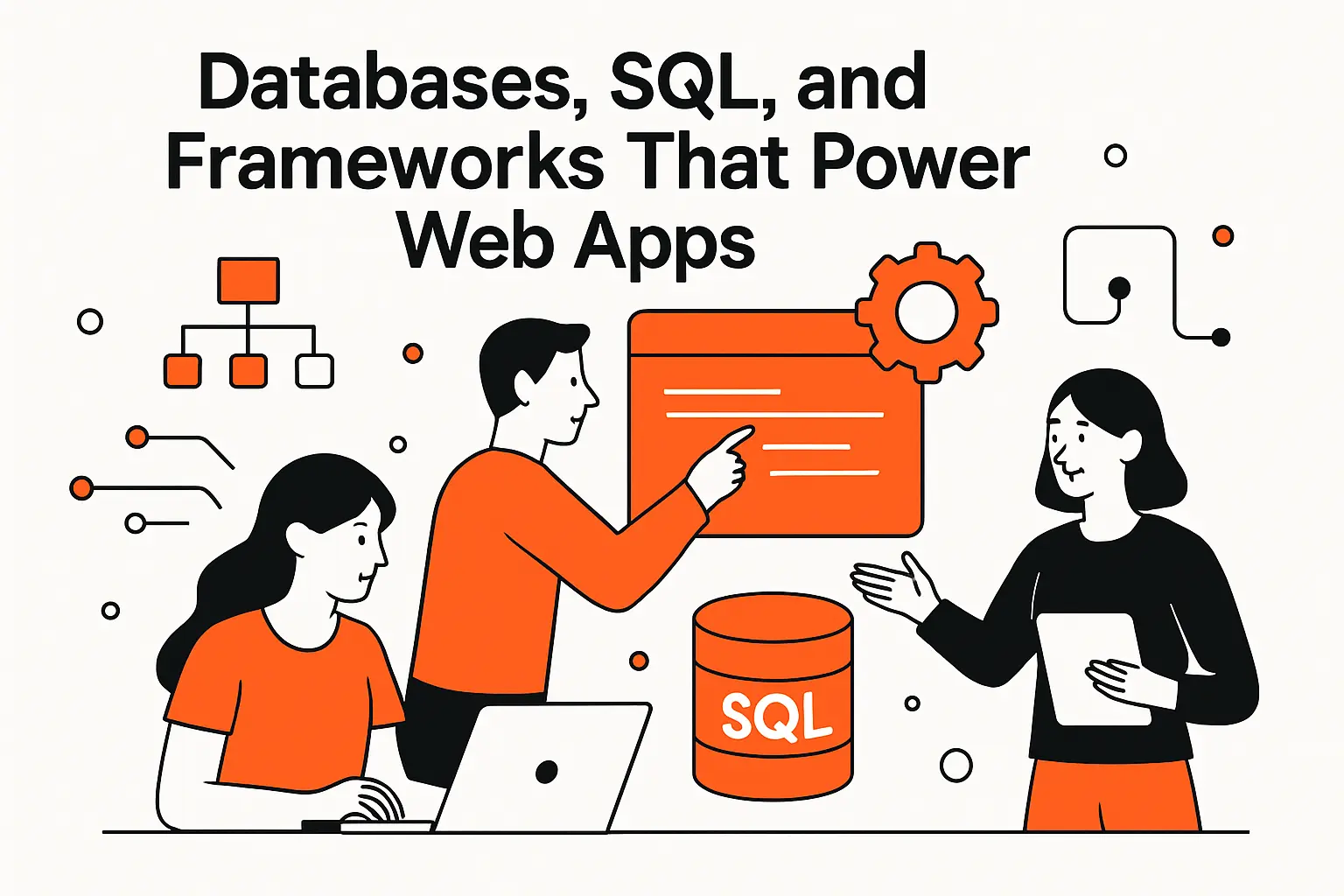
Applications are only as credible as their data. The database market’s momentum—Gartner reported a DBMS landscape totaling $119.7 billion—reflects how central data integrity, scalability, and governance have become. Choosing a language without modeling the data is like picking tires without knowing the road.
1. Relational Databases: MySQL and PostgreSQL
Relational systems remain the default because they encode rules about reality: keys, constraints, and transactions. PostgreSQL in particular offers a potent blend of reliability and power—ranging from rich indexing strategies to window functions and transactional DDL. MySQL’s ubiquity and operational familiarity remain assets, especially for applications that prize simplicity and read‑heavy patterns.
Our bias is to model relationally until a measured need proves otherwise. Normalize where it reduces duplication and anomalies; denormalize where query patterns and caches justify it. Choose indexes to serve your critical read paths, not just your ORMs. And test migrations the way you test features; schema changes are production events.
We prefer clear boundary layers: repositories or data mappers that prevent leakage of database idioms into domain code. That separation keeps you resilient if you later introduce read replicas, partitioning, or multi‑tenant strategies.
2. NoSQL Options: MongoDB
Document stores reward flexible schemas and episodic bursts of writes. When your domain tolerates shape evolution, or when you value aggregating heterogeneous records under a single key, MongoDB can fit beautifully. Modern versions provide robust transactional guarantees, which makes modeling trade‑offs more about query patterns than correctness fears.
The gotchas are predictable. Large unbounded arrays can wreak havoc on memory and index efficiency. Secondary indexing deserves design love up front. Time‑series and TTL features are gifts for event and log‑style data—use them to avoid building a bespoke archival layer.
In hybrid architectures, we often pair a relational system for authoritative state with a document store for collaboration features, activity feeds, or configurations that evolve alongside the product.
3. SQL and Data Modeling Basics
SQL remains a power tool for declaring intent: “what” over “how.” Start by articulating the questions your application must answer and the invariants that must hold. Use constraints to express business truths the database can enforce every time. Translate read patterns into indexes; translate write patterns into batching and sensible isolation choices.
Design your schema for the life you expect, not the demo you have. Historical tables, soft deletes, and append‑only audit trails pay off the first time something mysterious happens under load. If privacy requirements loom, plan pseudonymization and retention policies into the model rather than grafting them on after discovery requests arrive.
We’ve repeatedly seen that a clear data model unlocks velocity; code becomes simpler when the tables embed the rules you care about.
4. Key Back‑End Frameworks: Express, Django, Rails, Spring Boot, Laravel, ASP.NET
Frameworks are force multipliers when they align with your data model. Express gives you freedom to pick exactly the data access approach you prefer. Django’s ORM and admin make CRUD honest and traceable. Rails blends conventions that point you toward happy paths and includes migration ergonomics that keep the schema disciplined.
Spring Boot’s integrations with JPA and messaging middlewares excel in enterprise settings where the data estate spans many systems of record. Laravel’s Eloquent can be a delight if you keep business logic out of models and build service layers that express domain language clearly. ASP.NET’s data tooling and LINQ capabilities make querying expressive while staying performant and testable.
Our rule of thumb: choose the framework that best expresses your domain operations. If the framework encourages boilerplate to perform simple queries, those papercuts will turn into scar tissue by release season.
5. APIs: REST and GraphQL for Client–Server Data Exchange
REST plays well with caches and CDNs, which remain your cheapest, most reliable accelerators. If your domain fits resource metaphors, lean into them: nouns over verbs, standard status codes, and content negotiation that ages gracefully. GraphQL earns its keep when a single roundtrip must satisfy a complex view composed of disparate data needs, or when your clients proliferate with divergent constraints.
In both worlds, vigilant schema governance matters. Treat your schema like code: code review, contract tests, and consumer feedback loops. Add query ceilings and complexity analysis to prevent accidental denial‑of‑wallet events. And bake tracing into the API layer so you can observe which fields or routes cause real harm when new features launch.
How to Choose the Best Web App Language for Your Project

Teams often ask us for a simple matrix; reality is kinder to checklists than scorecards. One thing we emphasize is leverage: investments that accelerate delivery without amplifying risk. McKinsey’s analysis estimates productivity potential in software engineering on the order of 20 to 45 percent through tooling and workflow improvements. Language and framework choices determine whether you can harvest that potential or fight your tools every day.
1. Align with Project Requirements and Complexity
Start with what must be true for your product to win. Are the core operations workflow‑heavy with lots of human‑in‑the‑loop steps, or are they event‑driven and automated? Does your competitive moat live in data science, integrations, domain modeling depth, or user experience? The answers filter your options.
If your domain is still in flux, pick a language and framework that keep refactoring safe and fast. If your domain is stable but the integrations are sprawling, choose a platform with out‑of‑the‑box connectors, mature messaging support, and security primitives that map to your compliance needs. For greenfield products that will ship changes often, optimize for the developer experience; for platforms embedded in partner ecosystems, optimize for durable contracts.
We maintain architecture decision records that tie each technology choice to the product thesis it supports. When the thesis changes, the record tells us whether to pivot the stack or re‑commit to it.
2. Consider Performance, Scalability, and Security Needs
Performance is about patience: your users’ patience and your budget’s patience. Latency that feels fine in a lab can become a tax at scale. Favor languages with runtimes and patterns that make backpressure explicit and observability commonplace. For CPU‑bound hot paths, pick the right tool for the loop rather than forcing a generalist language to do specialist work.
Scalability is as much about operability as it is about throughput. Horizontal scaling hides sins until cost reports arrive; right‑sized services with predictable memory profiles are cheaper to run and easier to reason about. Security starts at the language and framework level: input validation, output encoding, and sane defaults around secrets and crypto. Then it continues through the supply chain: dependency hygiene, signing, and vulnerability response.
For us, a “secure by default” story is not a bumper sticker. It’s a platform stance: templates that include authentication and authorization patterns, lint rules that catch dangerous APIs, and pipelines that block images lacking provenance.
3. Evaluate Ecosystem, Libraries, and Community Support
Language popularity matters less than ecosystem quality. We look for maintained libraries that cover your use cases without detours into abandonware. Documentation culture is a leading indicator; healthy communities answer questions with clear examples rather than folklore. Mature frameworks that align with your mental model save months.
We also audit licensing. Mixing incompatible licenses can cause legal heartburn at the least convenient time. And we check long‑term support signals: if the community’s release discipline and upgrade guidance inspire confidence, you’ll ship more and firefight less.
Finally, we vet the testing culture. If idiomatic testing feels natural in a language and its frameworks, your team will actually do it. If not, tests become a chore and coverage evaporates with pressure.
4. Match to Team Expertise and Hiring Availability
Velocity lives in familiarity. Picking a language your team knows shortens cycles and lowers risk. But we balance that with hiring market realities. If your growth plans depend on adding contributors quickly, consider languages with broad, active talent pools and transferable skills from adjacent ecosystems.
We also weigh the cost of context switching. Full‑stack TypeScript is appealing when your feature teams own vertical slices across client and server. In contrast, a split between Python for data‑heavy services and Go for ingress can make sense when responsibilities map cleanly to team boundaries.
Training plans matter. If you’re banking on a language shift, carve out time and budget for learning, pilot projects, and dual‑running critical components until confidence rises.
5. Plan for Testing, Cross‑Browser Compatibility, and CI/CD
A language’s true cost appears in your delivery pipeline. We aim for testing pyramids that keep most checks fast and local while reserving end‑to‑end paths for integration risks. Browser variability still bites; compatibility suites and feature detection prevent last‑minute regressions that undermine trust.
CI/CD guardrails should be templates, not bespoke snowflakes. Container images hardened by default, dependency scanning, secret detection, and signed artifacts keep the path to production predictable. Feature flags turn deployment into a reversible choice rather than a cliff jump.
In our engagements, the winning pattern is “platform as a product.” We give teams paved roads with guardrails so they can focus on business logic, not wiring.
How TechTide Solutions Builds Custom Web Applications Aligned with Customer Needs
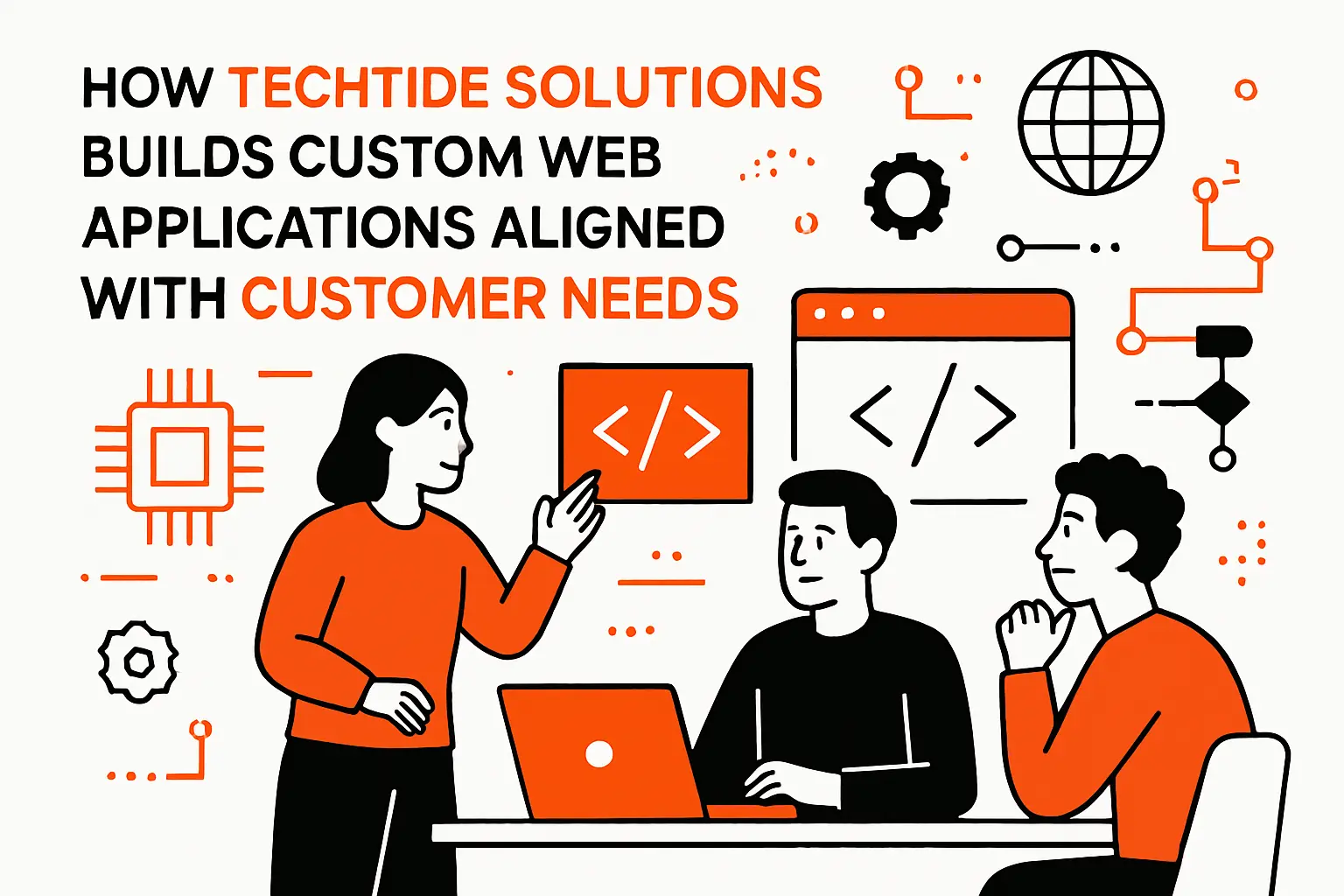
In a market where executive attention gravitates toward AI, research also reminds us that budgets shift without eliminating foundational needs: durability, security, and the talent to maintain what we build. We interpret these signals as a mandate to combine experimentation with operational excellence. Here is our approach, forged in production and tempered by incidents we learned from.
We start with discovery workshops that surface constraints and aspirations in the same breath: regulatory boundaries, data residency, existing systems we must honor, and the value narrative that would make the investment pay. From there, we propose architectural options with explicit trade‑offs, mapping features to sequences of risk‑reduction experiments.
Technical
Our technical blueprint includes a shared language list, interface contracts, and a seed repository per service that bakes in linting, tests, tracing, secrets management, and build pipelines. We ship “Hello, Observability” before “Hello, World.” Failure budgets and SLOs are negotiated up front with product, not bolted on after trouble tickets mount.
Front-end
On the front end, we harmonize design systems with code through component libraries, story catalogs, and visual regression tests. We prioritize progressive enhancement to keep the experience resilient under suboptimal network conditions. Accessibility is a gate, not a suggestion.
Back-end
On the back end, we implement boundaries that match the domain, not just the org chart. Where we must integrate with brittle legacy systems, we introduce anti‑corruption layers to keep upstream quirks from infecting core models. Event‑driven seams isolate failure and reduce cross‑team coupling. Caching is treated as data, not an afterthought, with explicit invalidation rules agreed early with product stakeholders.
Data manageent
Data strategy is integral: we collaborate with security and analytics teams to design schemas, retention, lineage, and access controls together. When experimentation calls for ML features, we bind them to service contracts and ethical guidelines so model behavior is observable and reversible.
Finally, we run joint delivery rituals: architecture office hours that remove bottlenecks, incident reviews that treat humans with respect, and platform roadmaps that evolve with product needs. Our goal is to build systems the business can change safely at will.
Conclusion and Next Steps for Learning Web App Languages
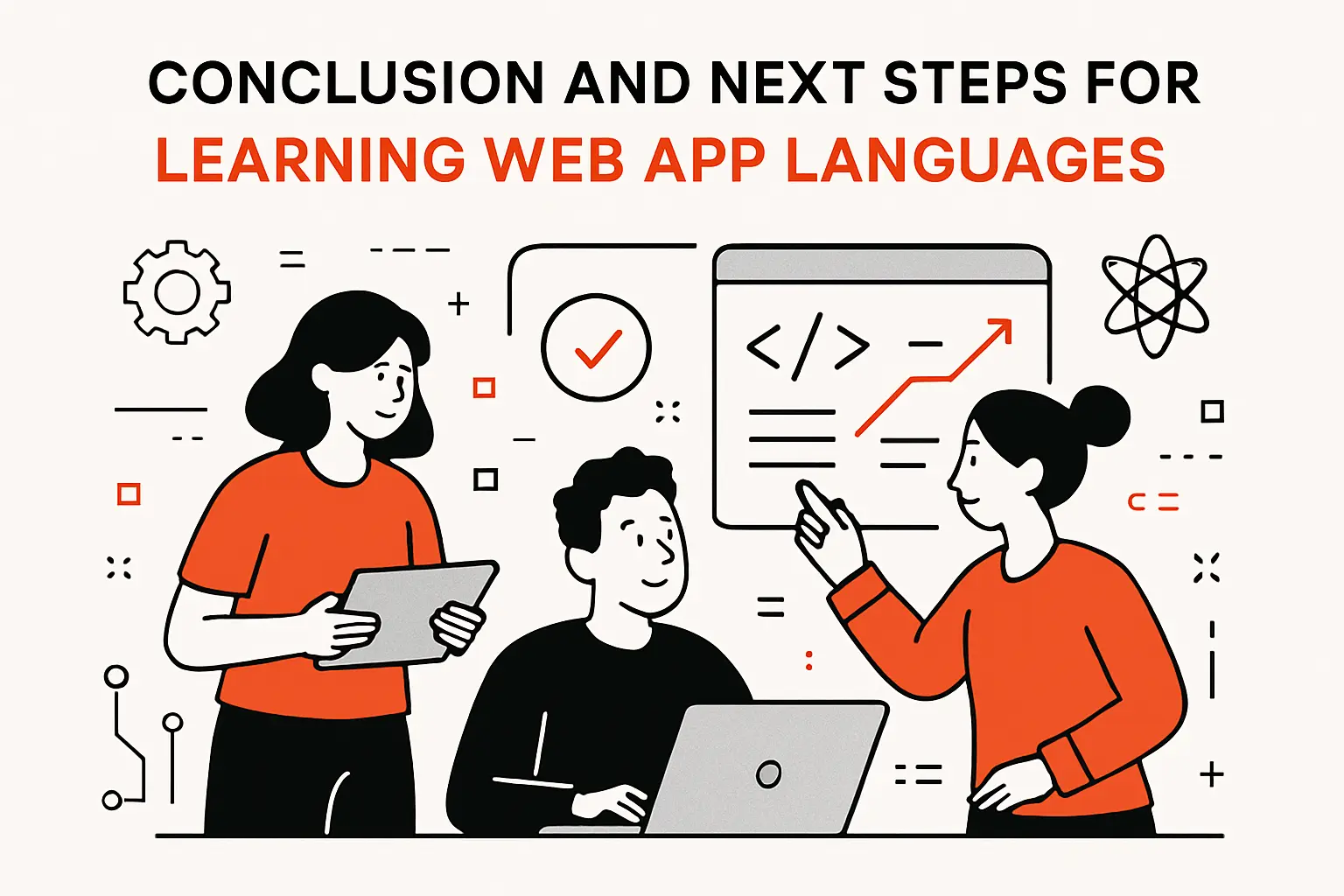
The web is not one stack but a set of trade‑offs you can learn to navigate. Industry research from established firms shows that software, data platforms, and developer productivity are moving targets, but the north star remains steady: make choices that reduce risk, increase clarity, and preserve optionality. As builders at Techtide Solutions, we’ve learned that the “best language” is the one that turns product intent into reliable value with the least ceremony.
1. Start with HTML, CSS, and JavaScript
Begin where the user lives. Learn semantic markup that communicates structure to both humans and machines. Practice layout techniques that reduce JavaScript dependency for responsiveness. Then layer in JavaScript with intention: small components, clear state transitions, and measurable interactions. As you grow, adopt TypeScript to make refactoring safe and to encode assumptions as types instead of folklore.
Build small projects that mirror real workflows: intake forms with validation and error recovery; dashboards with skeleton loading and empty‑state design; collaborative interactions that handle conflicts gracefully. The muscles you build here transfer directly to any framework you adopt later.
2. Learn a Back‑End Language and Framework
Pick one server‑side language whose mental model resonates with you and a framework that teaches good habits. Aim to ship a modest, complete application: authentication, persistence, background work, observability, and a deployment pipeline. Once you’ve felt the end‑to‑end path, you can compare how other ecosystems approach the same problems and add a second language if your ambitions or domain suggest it.
Use your first back end to practice the essentials that endure: clean contracts at the edges, proper error handling, and data models that reflect business truth. When you later join or lead a team, those instincts will matter more than the brand of framework on your résumé.
3. Adopt Best Practices: Accessibility, Testing, and Continuous Delivery
Make accessibility part of “done” rather than a separate task. Write tests that protect behavior users care about. Treat CI/CD as a habit that lowers risk: small changes, frequent merges, and deployments you can undo quickly. If you lean on new tooling—AI or otherwise—pair it with guardrails, code review, and observability so velocity never outruns integrity.
If you want a partner to pressure‑test your stack—or to co‑design a path from prototype to production—reach out. Tell us your top constraints and one thing your users absolutely love today. We’ll propose the shortest, safest next step to ship more value with less drama.



